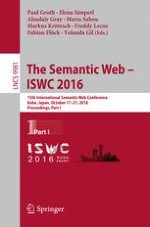2016 | OriginalPaper | Buchkapitel
Are Names Meaningful? Quantifying Social Meaning on the Semantic Web
verfasst von : Steven de Rooij, Wouter Beek, Peter Bloem, Frank van Harmelen, Stefan Schlobach
Erschienen in: The Semantic Web – ISWC 2016
Aktivieren Sie unsere intelligente Suche, um passende Fachinhalte oder Patente zu finden.
Wählen Sie Textabschnitte aus um mit Künstlicher Intelligenz passenden Patente zu finden. powered by
Markieren Sie Textabschnitte, um KI-gestützt weitere passende Inhalte zu finden. powered by
